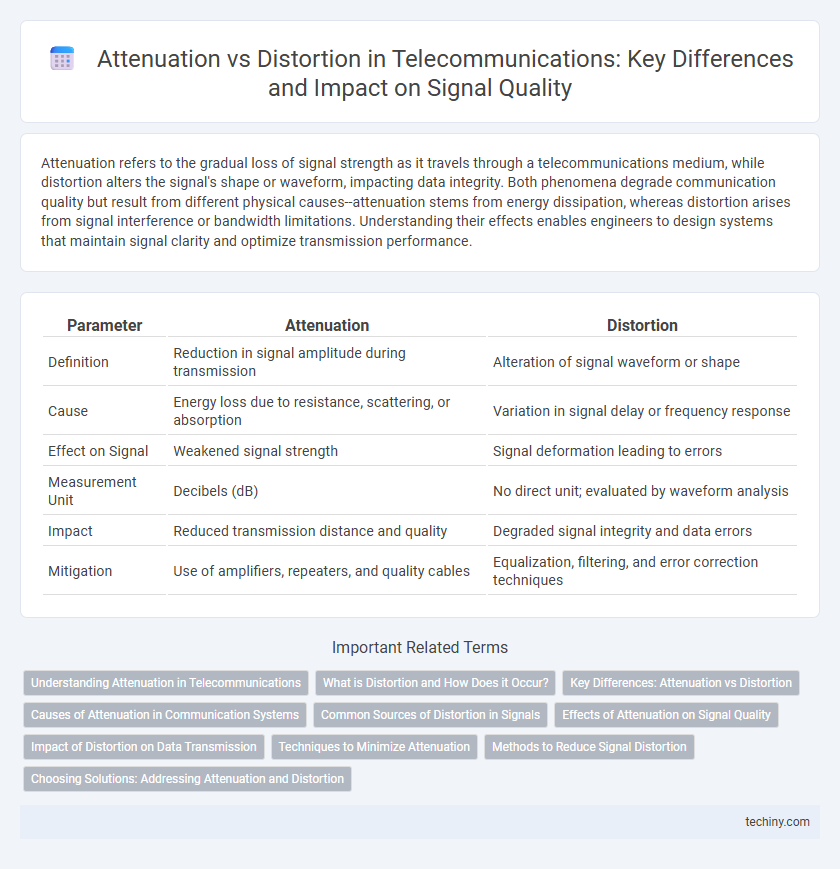Attenuation refers to the gradual loss of signal strength as it travels through a telecommunications medium, while distortion alters the signal's shape or waveform, impacting data integrity. Both phenomena degrade communication quality but result from different physical causes--attenuation stems from energy dissipation, whereas distortion arises from signal interference or bandwidth limitations. Understanding their effects enables engineers to design systems that maintain signal clarity and optimize transmission performance.
Table of Comparison
| Parameter | Attenuation | Distortion |
|---|---|---|
| Definition | Reduction in signal amplitude during transmission | Alteration of signal waveform or shape |
| Cause | Energy loss due to resistance, scattering, or absorption | Variation in signal delay or frequency response |
| Effect on Signal | Weakened signal strength | Signal deformation leading to errors |
| Measurement Unit | Decibels (dB) | No direct unit; evaluated by waveform analysis |
| Impact | Reduced transmission distance and quality | Degraded signal integrity and data errors |
| Mitigation | Use of amplifiers, repeaters, and quality cables | Equalization, filtering, and error correction techniques |
Understanding Attenuation in Telecommunications
Attenuation in telecommunications refers to the gradual loss of signal strength as it travels through a transmission medium, such as copper cables, fiber optics, or wireless channels. This weakening occurs due to factors like resistance, scattering, and absorption, reducing the signal's amplitude without necessarily altering its waveform. Understanding attenuation is crucial for designing communication systems that maintain signal integrity over long distances by implementing amplification or repeaters.
What is Distortion and How Does it Occur?
Distortion in telecommunications refers to any alteration of the original signal's waveform during transmission, causing the received signal to differ from the transmitted one. It occurs when various frequency components of the signal experience unequal delays or amplitude changes, often due to channel imperfections like nonlinearities, multipath propagation, or varying transmission media characteristics. This results in degraded signal quality, impacting data integrity and communication system performance.
Key Differences: Attenuation vs Distortion
Attenuation refers to the reduction in signal strength as it travels through a medium, primarily caused by energy loss due to absorption, scattering, or bending. Distortion involves the alteration of the signal waveform or shape, typically resulting from dispersion, nonlinearities, or phase shifts within the transmission channel. While attenuation degrades signal amplitude, distortion affects the quality and integrity of the transmitted information, making both critical parameters in telecommunications system design and performance optimization.
Causes of Attenuation in Communication Systems
Attenuation in communication systems occurs due to signal power loss as it travels through the transmission medium, primarily caused by resistance in electrical cables, absorption in optical fibers, and spreading of electromagnetic waves in wireless channels. Materials with high conductivity and dielectric losses increase attenuation, reducing signal strength and quality over distance. Understanding these factors is essential for designing efficient networks that maintain signal integrity by minimizing power dissipation and optimizing transmission paths.
Common Sources of Distortion in Signals
Common sources of distortion in telecommunications signals include multipath propagation, where signals take multiple paths causing phase shifts and signal overlap, and non-linearities in amplifiers that create harmonic generation and intermodulation distortion. Frequency-dependent components like filters and cables introduce group delay variations, affecting signal timing and causing waveform deformation. Additionally, temperature fluctuations and component aging can alter circuit behavior, further contributing to signal distortion.
Effects of Attenuation on Signal Quality
Attenuation in telecommunications reduces signal amplitude, causing a weaker signal that can lead to data loss and increased bit error rates. This loss of signal strength compromises communication range and degrades overall signal quality, making it difficult for receivers to accurately interpret the transmitted information. Proper amplification and signal boosting are critical to counteract attenuation and maintain optimal signal integrity throughout the transmission path.
Impact of Distortion on Data Transmission
Distortion in telecommunications alters the shape of signal waveforms, causing errors in data interpretation and reducing transmission quality. Unlike attenuation, which primarily decreases signal strength, distortion affects the timing and integrity of the signal, leading to increased bit error rates in digital communication systems. Managing distortion through equalization and advanced modulation techniques is crucial for maintaining high-speed and reliable data transmission.
Techniques to Minimize Attenuation
Attenuation in telecommunications refers to the reduction of signal strength over distance, which can degrade data transmission quality. Techniques to minimize attenuation include using low-loss cables such as fiber optics, deploying signal repeaters and amplifiers at regular intervals, and optimizing transmitter power levels to maintain signal integrity. Employing advanced materials and improving cable shielding also significantly reduce signal degradation caused by environmental factors.
Methods to Reduce Signal Distortion
Signal distortion in telecommunications is minimized through equalization techniques that adjust frequency response to counteract channel imperfections and adaptive filtering that dynamically compensates for time-varying distortions. Error correction codes, such as Reed-Solomon and convolutional codes, improve signal integrity by detecting and correcting errors introduced during transmission. Digital signal processing algorithms further enhance signal quality by mitigating nonlinear distortions and inter-symbol interference, ensuring accurate data recovery.
Choosing Solutions: Addressing Attenuation and Distortion
Attenuation causes signal strength to weaken over distance, while distortion alters the signal's shape, both degrading communication quality. Selecting appropriate solutions involves using amplifiers or repeaters to combat attenuation and equalizers or digital signal processing to minimize distortion effects. Properly balancing these technologies ensures optimal signal integrity and reliable telecommunication performance.
Attenuation vs Distortion Infographic

 techiny.com
techiny.com